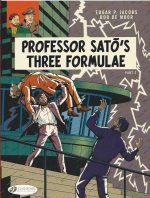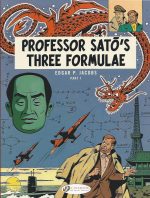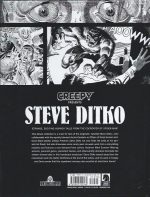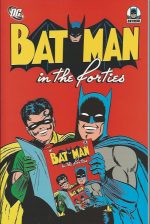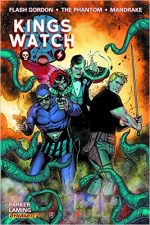
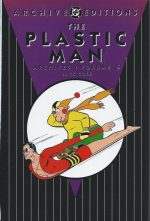
By Jack Cole & various (DC Comics)
ISBN: 978-1-4012-0154-8
Jack Cole was one of the most uniquely gifted talents of America’s Golden Age of Comics. Before moving into mature magazine and gag markets he originated landmark tales in horror, true crime, war, adventure and especially superhero comicbooks, and his incredible humour-hero Plastic Man remains an unsurpassed benchmark of screwball costumed hi-jinks: frequently copied but never equalled. It was a glittering career of distinction which Cole was clearly embarrassed by and unhappy with.
In 1954 he quit comics for the lucrative and prestigious field of magazine cartooning, swiftly becoming a household name when his brilliant watercolour gags and stunningly saucy pictures began regularly running in Playboy from the fifth issue.
Cole eventually moved into the lofty realms of newspaper strips and, in May 1958, achieved his life-long ambition by launching a syndicated newspaper strip, the domestic comedy Betsy and Me.
On August 13th 1958, at the peak of his greatest success, he took his own life. The reasons remain unknown.
Without doubt – and despite his other triumphal comicbook innovations such as Silver Streak, Daredevil, The Claw, Death Patrol, Midnight, Quicksilver, The Barker, The Comet and a uniquely twisted and phenomenally popular take on the crime and horror genres – Cole’s greatest creation and contribution was the zany Malleable Marvel who quickly grew from a minor back-up character into one of the most memorable and popular heroes of the era. “Plas†was the wondrously perfect fantastic embodiment of the sheer energy, verve and creativity of an era when anything went and comics-makers were prepared to try out every outlandish idea…
Eel O’Brian was a brilliant career criminal wounded during a factory robbery, soaked by a vat of spilled acid and callously abandoned by his thieving buddies. Left for dead, he was saved by a monk who nursed him back to health and proved to the hardened thug that the world was not just filled with brutes and vicious chisellers after a fast buck.
His entire outlook altered and now blessed with incredible elasticity, Eel resolved to put his new powers to good use: cleaning up the scum he used to run with.
Creating a costumed alter ego he began a stormy association with the New York City cops before being recruited as a most special agent of the FBI…
He soon picked up the most unforgettable comedy sidekick in comics history. Woozy Winks was a dopey, indolent slob and utterly amoral pickpocket who accidentally saved a wizard’s life and was blessed in return with a gift of invulnerability: all the forces of nature would henceforth protect him from injury or death – if said forces felt like it.
After failing to halt the unlikely superman’s determined crime spree, Plas appealed to the scoundrel’s sentimentality and, once Woozy tearfully repented, was compelled to keep him around in case he strayed again. The oaf was slavishly loyal but perpetually back-sliding into pernicious old habits…
Equal parts Artful Dodger and Mr Micawber, with the verbal skills and intellect of Lou Costello’s screen persona or the over-filled potato sack he resembled, Winks was the perfect foil for Plastic Man: a lazy, greedy, morally bankrupt reprobate with perennially sticky fingers who got all the best lines, possessed an inexplicable charm and had a habit of finding trouble. It was the ideal marriage of inconvenience…
This fifth full-colour hardback exposes more eccentrically exaggerated exploits of the elastic eidolon from Police Comics #50-58 and Plastic Man #4 (stretching from January to September 1946), and opens here with an appreciation of Cole and his craft by Bill Schelly in the Foreword before a bizarre mystery confounds the populace as ‘Plastic Man Protects Crookdom’.
When a celebrated astrologer is murdered, his dying prediction seems to confirm that the chameleonic crimebuster is cursed to save his killers from the law… but they haven’t heard the victim’s entire utterance…
Police #51 then details how twisted, frustrated love turns a gorgeous but frog-throated operatic chanteuse into a deadly, rock-fisted killer dubbed ‘The Granite Lady’. Even after her mad scientist paramour returns her to flesh-&-blood, her heart remains stony cold…
‘Crime without Criminals’ sees the city devoid of all underworld activity thanks to the efforts of Plas and Woozy. However, nature abhors a vacuum and this time it’s filled by an unlikely new crew of bandits, just in time to take the edge off our heroes’ mounting boredom…
Cole always had a grand line on mad scientists and in ‘The Evil Genius of Dr. Erudite’, came up with a classic loon like no other. This passionate maniac had so many great crime ideas he had no time to implement them. Realising the only solution was to replicate himself, he began an anarchic spree but was surprised by two unforeseen factors: Plastic Man’s determination to stop him and his own duplicate’s rebellious nature…
Cerebral conundra continued to vex our heroes in Police #54 as a moronic sneak thief became a lethal menace to America after swiping ‘The Thinking Machine’. Thankfully Plastic Man was on hand to fight and Woozy to balance the scales of natural imbecility…
Issue #55 revealed the genesis and just deserts of ‘Sleepy Eyes’ as a cheap crook realises he has the power to plunge folk into unshakeable comas…
Cole’s constant and still-growing pressure to fill pages led to the hiring of numerous artists to draw his madcap scripts. This is clearly seen in Plastic Man #4 (Summer 1946) which opens with ‘The Purple Viking’ (illustrated by Bart Tumey), wherein a longboat full of ancient Norse reivers invades a quiet seaside hamlet, just as Plas and Woozy check in for a quiet weekend. How odd that the beach town is trashed by invaders just as a developer is checking out prospective new resort sites…
A crooked political-boss trying to set up his own country inside America is no match for the Pliable Paladin in ‘King Lughead the First’ (art by John Spranger). Not only are all his larcenous efforts to fill the Treasury foiled, but new Prime Minister Mr. Winks is so dumb he might as well be working for the other side…
The stooge once more becomes the star as Woozy stumbles into ‘The Lollypop Caper’ (Tumey again), chasing gem-filled candy sought by rival mobs and a rather dangerous toddler…
Plastic Man’s uncanny deductive abilities are then propounded in prose short ‘Plas’ to Meet You’ before the capture of arch-thug ‘The Lobster’ leads to Woozy being adopted and Plas stumbling into a cunning conspiracy…
Plastic Man #56 then dabbled with childish whimsy as ‘Overworked Genie’ (art by Andre Leblanc) sees the stretchable sleuth take a day off to spend his time granting wishes to a little kid. However, crime never sleeps and all too soon greedy thugs are trying to steal Mickey’s lamp. Big mistake…
A growing public fascination with and appetite for flying saucer stories informs ‘Mars – Keep Away’ (Spranger art) as the mysterious Mr. Misfit inserts his diminutive self into Plas and Woozy’s hunt for stolen atomic fuel and a flamboyantly crackpot rocketry loon dubbed Professor MacGhoul, after which this slice of vintage class concludes with a deadly duel against murderously marauding vegetable villain ‘The Green Terror’ (illustrated by Alex Kotsky)…
Augmented by all the astoundingly ingenious covers, this is a true gem of funnybook virtuosity: still exciting, breathtakingly original, thrilling, witty, scary, visually outrageous and pictorially intoxicating more than seventy years after Jack Cole first put pen to paper.
Plastic Man is a unique creation and this is a magical experience comics fans would be nuts to miss.
© 1946, 2003 DC Comics. All Rights Reserved.


